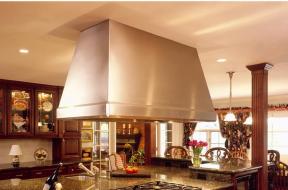DIY kitchen vent
Installing a vented range hood not only makes your kitchen smell better, it improves air quality too
If you’ve ever fried fish in a kitchen without a range hood, you know that an active kitchen can be a pretty smelly place when things really get cooking. But it may surprise you to know that unvented cooking can also severely reduce the quality of the air inside your home. According to one recent study, an average family can generate up to 200 lbs. of grease, smoke and steam each year from cooking. So if you’re currently cooking without a vented range hood, you may be inhaling a lot of steam and grease you don’t need to be and leaving a lot of dirt to build up on your walls. The picture gets even worse during the cold months, when your windows are closed.
Unvented
despite the fact that a lot of homes already have a range hood, it may not be doing much to improve indoor air quality. That’s because unvented hoods simply recirculate the air by drawing it through a filter and blowing it back into the room rather than exhausting it outside. For a range hood to be effective, it must exhaust the dirty air to the outdoors and should do so at a rate of at least 150 cubic feet per minute (CFM).
Power up
If you already have a non-vented range hood in place, change over the electrical connections to power the new unit. If you don’t, you’ll need to locate a suitable power source nearby that you can tap into and have your electrical work inspected. Range hoods don’t draw a lot of power, but be sure you don’t overload existing circuits. If you are at all unsure about the electrical connections needed for this project, rough in the hood and call a licensed electrician to make the final wiring hookup for you.
Easy exit
In this project, the range sat against an exterior wall at the front of the house, so we ran the exhaust duct straight up through the ceiling, through a small attic space and onto the roof. In many cases the duct could have run straight out and through the exterior wall. Regardless of the route, be sure it ends outdoors. Never end a ventilation duct inside an attic.
Jump to a section
- Page 1 : You may be inhaling a lot of steam and grease without a stove vent
- Page 2 : Step-by-step
To leave a comment, please log in












No comments